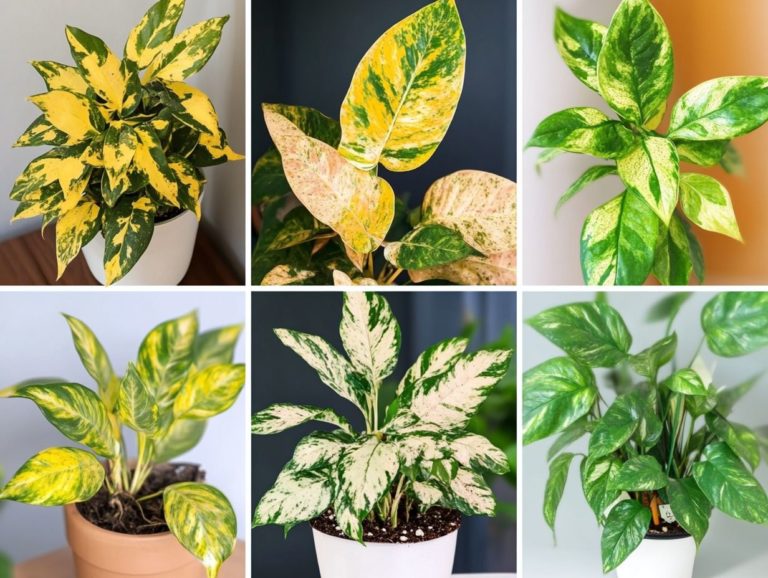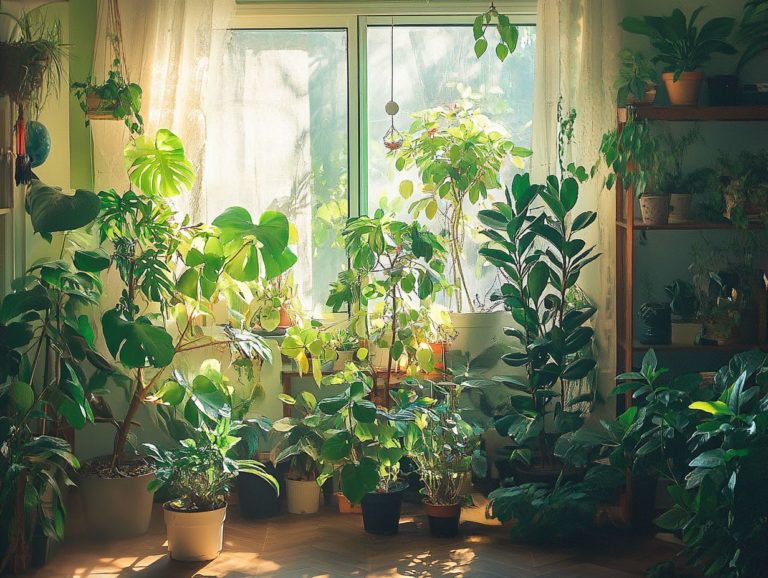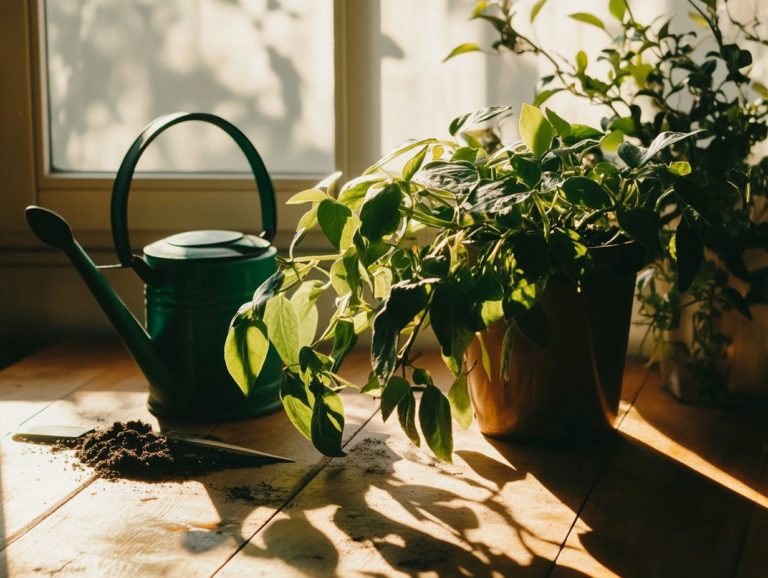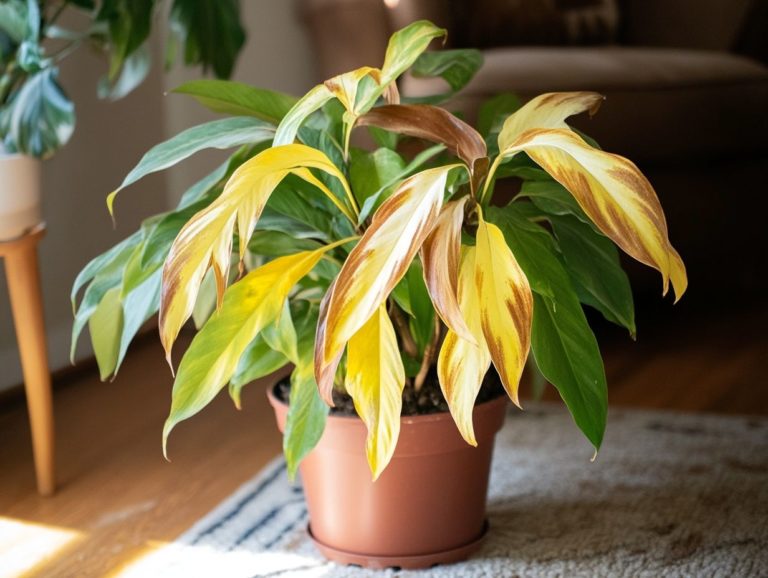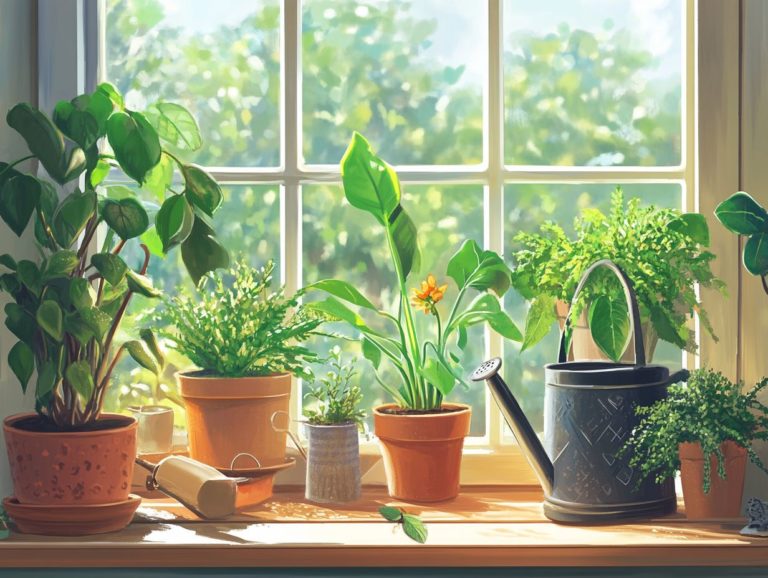How to Help Indoor Plants Overcome Stress
Indoor plants infuse life and vibrancy into your spaces, but remember, they can experience stress just like you. Discovering why your plants are stressed can be a game-changer for their health!
From environmental factors to pest infestations, identifying the signs early can significantly impact your plants’ well-being. This guide will empower you to recognize stress in your indoor plants and provide practical solutions to help them thrive once more.
Explore effective watering techniques, light requirements, and preventive measures to cultivate a healthier indoor garden. Your green companions will appreciate your efforts!
Contents
- Key Takeaways:
- Understanding Plant Stress
- Identifying Stress in Indoor Plants
- Common Causes of Indoor Plant Stress
- Ways to Help Indoor Plants Overcome Stress
- Preventive Measures for Future Stress
- Frequently Asked Questions
- How can I tell if my indoor plant is stressed?
- What are the main causes of stress in indoor plants?
- How can I improve lighting for my indoor plants?
- What is the best way to water indoor plants?
- What should I do if my indoor plant has pests or diseases?
- How can I create a stress-free environment for my indoor plant?
Key Takeaways:

- Maintain proper watering, provide adequate light, and ensure your plants receive the right nutrients to help them overcome stress.
- Manage regular care and maintenance, including addressing pests and diseases, to prevent future stress in indoor plants.
- Create and uphold a healthy indoor environment to effectively prevent and manage stress in your plants.
Understanding Plant Stress
Grasping the intricacies of plant stress is vital for anyone immersed in the world of gardening, whether nurturing indoor plants or cultivating outdoor gardens. This understanding bridges the gap between plant health and human well-being.
Research shows that engaging with plants brings joy and elevates mood while helping diminish psychological stress and enhancing overall life satisfaction. Caring for plants helps you connect with nature. It’s more than just enjoying how they look.
This nurturing act fosters a profound bond with your environment, offering a pathway to anxiety relief and cultivating a sense of community among fellow plant enthusiasts, especially within gardening clubs.
Causes and Symptoms
The causes of plant stress can be as varied as the challenges you face in your life, stemming from environmental factors to symptoms that reveal distress.
Recognizing these signs is essential; issues such as inadequate lighting, erratic watering patterns, and nutrient deficiencies can seriously compromise your plants’ health. For instance, if your plants aren’t getting enough sunlight, you might notice their leaves yellowing and dropping. Overwatering can lead to wilting and root rot, which occurs when roots sit in water and decay. By paying close attention to these symptoms, you can gain a deeper understanding of your plants’ needs and cultivate an optimal growing environment.
This proactive approach enhances how your garden looks and nurtures a resilient and flourishing ecosystem.
Identifying Stress in Indoor Plants
Identifying stress in your indoor plants is crucial for their well-being. It can greatly elevate your mood and ultimately help alleviate your own stress!
The benefits of caring for your plants extend far beyond their green leaves, enriching your environment and enhancing your overall quality of life.
Signs to Look Out For
Pay attention to signs in your indoor plants that may indicate stress look for wilting leaves, discoloration, and unusual growth patterns.
These symptoms are critical indicators of underlying issues that could greatly affect your plant’s overall health. When you notice drooping leaves or a loss of bright color, it s usually a sign that your plant is under-watered or may be exposed to extreme temperatures.
If you observe abnormal growth patterns like stunted or excessively elongated stems, it could mean your plant is struggling to adapt to its environment, likely due to insufficient light or nutrient deficiencies. Act now! Recognizing these stress signals early is essential. By tending to your plants proactively, you promote their recovery and enhance the aesthetic and emotional benefits these green companions bring to your living spaces. For more detailed guidance, check out how to overcome indoor plant stress.
Common Causes of Indoor Plant Stress
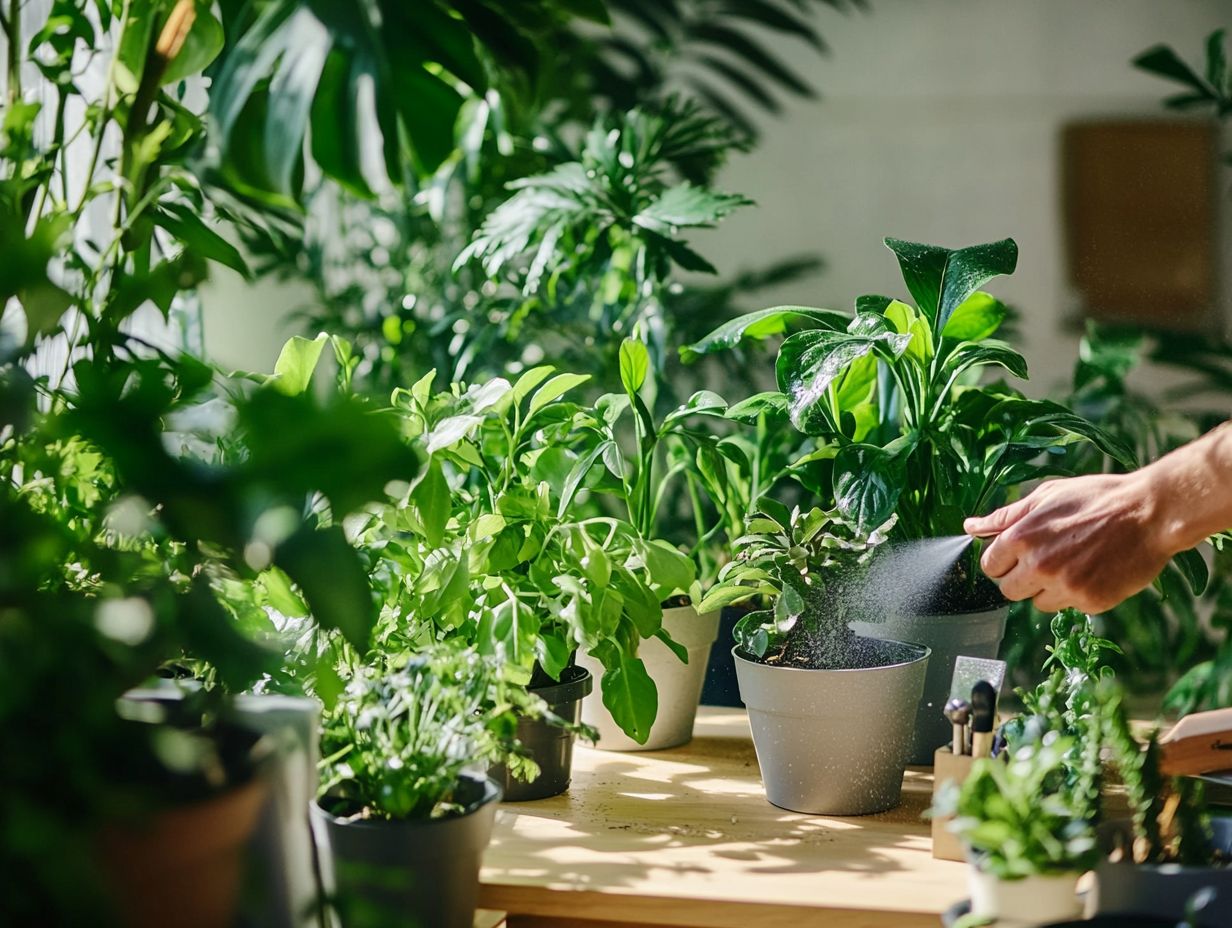
Common causes of indoor plant stress include a variety of factors, such as environmental influences and pest infestations, all of which can profoundly impact the health and vitality of your plants.
Environmental Factors
Environmental factors like light conditions, humidity, temperature, and air quality significantly influence the health of your indoor plants.
When these elements aren t optimized, your plants can experience unnecessary stress. This might show up as wilting, yellowing leaves, or stunted growth. If your plants aren t getting enough light, their ability to photosynthesize which means making food from light could suffer. Excessively dry air can lead to moisture loss, causing them to decline.
To address these challenges, it s crucial to monitor light levels carefully and maintain consistent humidity through misting or using humidifiers. Regulating temperature with proper ventilation and ensuring good air circulation are also essential.
By fostering a balanced indoor environment, you not only enhance your plants’ vitality but also create a space that positively impacts your mental well-being. For tips for keeping indoor plants thriving, this results in a serene and rejuvenating atmosphere.
Pest and Disease Infestations
Pests and diseases are notorious for causing significant stress in your indoor plants. These issues often manifest through a variety of symptoms that demand swift intervention. As indoor gardening gains traction, it s essential to familiarize yourself with different types of pests, such as aphids, spider mites, and mealybugs.
These unwelcome visitors leave unmistakable signs behind, like yellowing leaves, sticky residue, or visible webbing. These can escalate quickly if left unchecked.
Diseases like root rot and powdery mildew can severely compromise your plants’ vitality. It s vital to seek effective treatment solutions. To prevent these issues, implementing preventive steps like mastering proper watering techniques and ensuring adequate airflow is crucial for cultivating a thriving indoor garden.
Remember, nurturing healthy greenery can provide psychological perks, such as reducing stress and boosting your overall well-being. If you find yourself struggling with plants that have been over-fertilized, learn how to revive over-fertilized indoor plants. Embrace your role as a caregiver for your indoor oasis, and watch both your plants and your peace of mind flourish.
Ways to Help Indoor Plants Overcome Stress
To help your indoor plants thrive and overcome stress, it’s vital to employ effective strategies. This includes ensuring they receive proper watering, adequate light, and essential nutrients.
Proper Watering Techniques
Proper watering techniques are essential for maintaining optimal moisture levels in your indoor plants. This helps you avoid the pitfalls of both overwatering and underwatering.
To establish an effective watering schedule, consider the specific needs of each plant species, the size of the pot, and the ambient humidity and temperature in your space. For example, succulent varieties thrive on less frequent watering, while tropical plants often require a more consistent approach.
Keep a close eye on your soil moisture. Allow it to dry out partially before the next round of watering. By doing this, you can ensure that your indoor plants receive just the right amount of hydration. If you’ve been away, consider these tips for reviving indoor plants after travel for vibrant, healthy growth.
Providing Adequate Light and Nutrients

Providing adequate light and nutrients is essential for the growth of your indoor plants. This directly influences their health and resilience against stress.
Different species have distinct light requirements. For example, while succulents flourish in bright, direct sunlight, ferns often prefer the softer, indirect light found in cozy, shadier corners of your room.
By selecting appropriate fertilizers tailored to the type of plant, you can enhance their growth rates and bring out vibrant colors. This cultivates a flourishing indoor garden. It’s also important to be aware of recognizing stress signs in indoor plants. The joy of nurturing plants extends beyond mere aesthetics; fostering greenery can offer significant psychological benefits, instilling tranquility and boosting your overall well-being as they transform your living space into a serene oasis.
Start caring for your indoor plants today and join the journey of nurturing your indoor garden!
Managing Pests and Diseases
Effectively managing pests and diseases is essential for maintaining plant health and minimizing stress in your indoor plants. This approach enhances their vitality, promotes lush growth, and ensures vibrant foliage.
To achieve this, consider utilizing a blend of natural remedies, such as neem oil and insecticidal soaps. These options are effective and gentle on the environment. Additionally, employing sound plant care techniques, like rotating your plants regularly and maintaining optimal humidity levels, can significantly decrease the likelihood of infestations.
By nurturing a balanced ecosystem within your indoor spaces, you create a thriving environment where healthy plants flourish. Healthy plants brighten your space and improve your mood!
Preventive Measures for Future Stress
Implementing preventive measures cultivates a healthy indoor environment for your plants, enhancing their longevity and resilience.
Maintaining a Healthy Indoor Environment
Maintaining a healthy indoor environment is essential for your plants’ well-being. Focus on air quality, light levels, and humidity.
A well-ventilated space minimizes the risk of mold and pests, fostering an environment that promotes your plants’ growth. Providing adequate light tailored to each species’ needs ensures they flourish and bloom beautifully.
Meanwhile, maintaining the right humidity levels prevents wilting and encourages vibrant leaves. Each of these factors plays a unique role in plant health, managing stress, and promoting lush development.
Thoughtfully considering these elements allows you to create a nurturing oasis that enhances your home s aesthetic appeal while boosting the vitality of your cherished greenery.
Regular Plant Care and Maintenance
Regular plant care and maintenance routines are crucial for ensuring the health and vibrancy of your indoor plants, yielding long-term rewards.
Engaging in consistent practices like pruning, repotting, and fertilizing significantly enhances the well-being of your leafy companions. Pruning encourages growth while removing dead or unhealthy leaves, allowing your plants to thrive.
Repotting provides necessary space and fresh soil, preventing issues like root rot (a condition where roots decay due to excess moisture) and nutrient depletion. Fertilizing replenishes the essential minerals your plants need for lush foliage and vibrant blooms.
Beyond the health benefits for the plants, these activities deliver psychological perks, offering a sense of accomplishment and creating a calming atmosphere that positively impacts your mental well-being.
Frequently Asked Questions
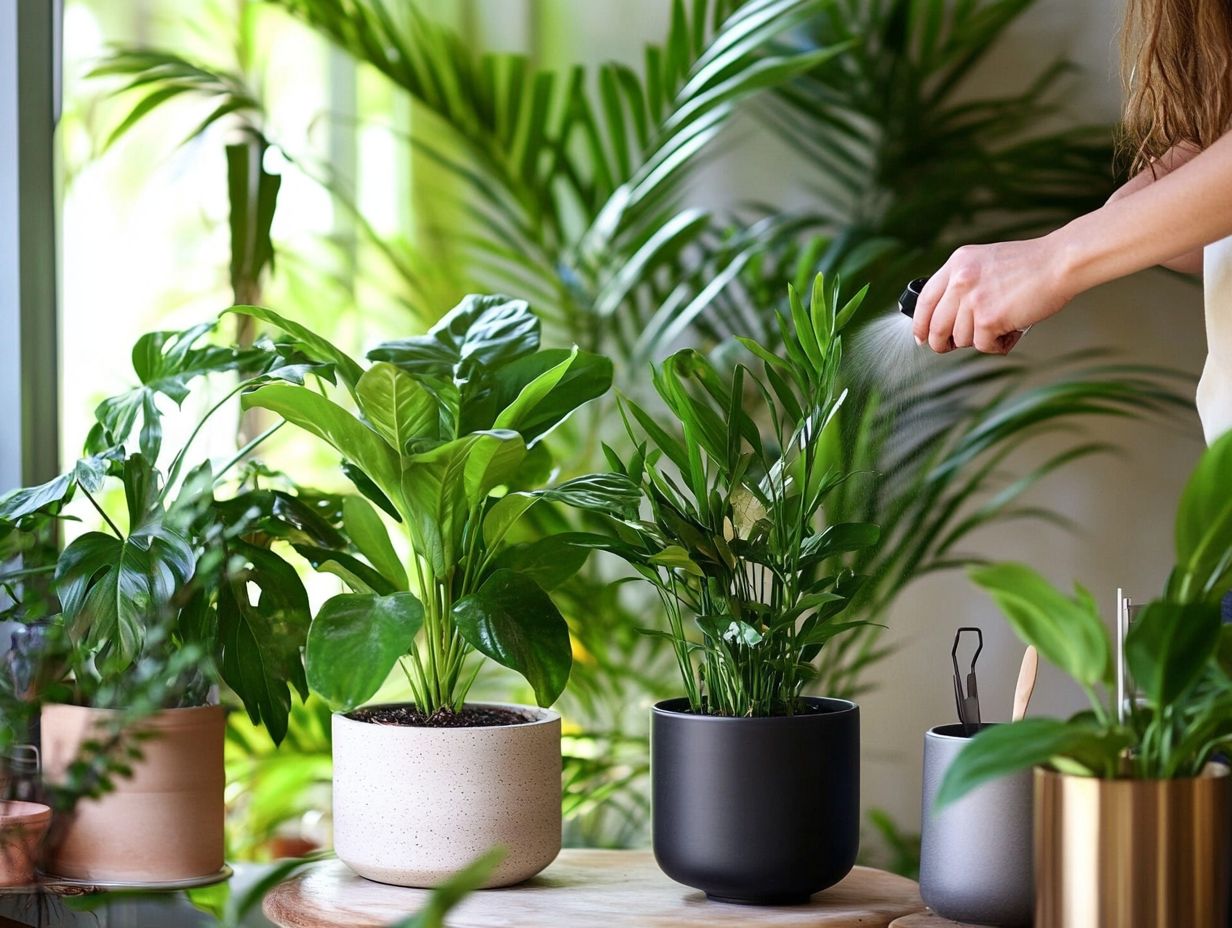
How can I tell if my indoor plant is stressed?
Look for signs like yellowing leaves or wilting. If you notice these, your plant needs help!
What are the main causes of stress in indoor plants?
Several factors can contribute to stress in indoor plants, including inadequate lighting, improper watering, pests or diseases, and temperature fluctuations. Identifying the cause is crucial for your plant’s survival!
How can I improve lighting for my indoor plants?
If your indoor plant is not receiving enough light, consider moving it to a brighter location or supplementing with artificial lighting. Rotate your plant regularly to ensure all leaves receive adequate light.
What is the best way to water indoor plants?
Proper watering is essential for a healthy indoor plant. Water evenly and thoroughly, allowing excess water to drain out of the pot. Avoid overwatering or letting the plant sit in water for extended periods.
What should I do if my indoor plant has pests or diseases?
If you notice pests or diseases on your indoor plant, act quickly to prevent further damage. Try using natural pest control methods, such as neem oil, and prune away any infected or damaged parts of the plant.
How can I create a stress-free environment for my indoor plant?
To help your indoor plant thrive, provide a stable and consistent environment.
Maintain proper lighting, temperature, and moisture in the air. Avoid sudden changes or drafts to keep your plant happy!

